Archive for December, 2012
Friday, December 28th, 2012
By Carolyn Yeager
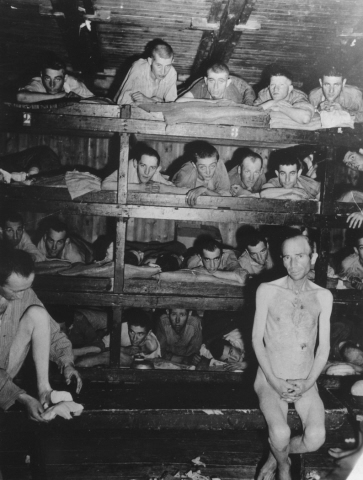 Here we see a very bizarre scene of clothed men being photographed lying in bunks, while a naked man sits on a bench in front of them. They are not looking at him and he seems unaware of them. And why not? This is clearly a composite photograph made up of two unrelated scenes.
Here we see a very bizarre scene of clothed men being photographed lying in bunks, while a naked man sits on a bench in front of them. They are not looking at him and he seems unaware of them. And why not? This is clearly a composite photograph made up of two unrelated scenes.
The United States Holocaust Memorial Museum (USHMM) titles this photo #78713 “Survivors lie on wooden bunks that are four tiers high in a barracks in the Buchenwald concentration camp.”
No mention of the naked man. This is truly fitting of the expression “the elephant in the living room” wherein everyone pretends not to notice something they can’t or don’t want to try to explain.
The description by the USHMM goes on to say:
The original caption reads, “This photo shows the conditions and the amount of sleeping space for the prisoners at Buchenwald concentration camp. They range from young kids to old men, all doing the same amount of work each day.”
According to the Signal Corps caption, the photo was taken on April 23, 1945.
Yet the official date given for this photo on the USHMM Online Archive page is: Wednesday, April 11, 1945 – Monday, April 23, 1945; the photographer Donald R. Ornitz; courtesy of Mary Dickinson.
April 11 was “Liberation Day” and they always want to give the impression that all the pictures were taken on that day — that everything seen is unrehearsed and just as the liberating army found it. Yet this photo was “set up” 12 days after liberation. Another point: Where are the “old men,” and where are the “young kids” in this photo? They all look to be in their late teens and 20’s up to their 30’s at the most. No old men, no young kids. What were these ex-‘prisoners’ doing during those 12 days; where were they living? How were they being treated? Well, they were being asked to participate in the creation of the post-war propaganda ordered by Eisenhower, and that is what they did. Were they paid? What were they promised? Did they just hang around in the barracks as usual?
The naked man and his strange shadow
The men in the bunks are not sick or emaciated – they appear healthy and alert – so the military intelligence division responsible for creating photographic propaganda decided to add a sick man to the photo in order to support the message they were charged to send to the world of sub-human conditions at Buchenwald. It’s not hard to see how they did it — the two men on the bench were super-imposed on the other picture. The top edge of the bench is lined up with the bottom slat of the bunk, giving the impression that the bench is some feet away from the bunk. [I’ve copied the photo again for ease of seeing it while reading.]
 So far so good. But once again, the shadows present a problem. Notice that there is a dark shadow behind every man in the bunk cast on the wall behind him, due to the bright flash of the camera and maybe even a spotlight shining on them. The naked man also has a similar black shadow around his head and along his right side although there is only empty space behind him. There is no wall, so what is the shadow being made on? Notice there is no shadow created by his legs. This shadow seems to me to be totally impossible. We don’t see a shadow made “in the air” behind the standing naked man in the Famous Buchenwald Lie-beration photo discussed in the previous posts. But here we do.
So far so good. But once again, the shadows present a problem. Notice that there is a dark shadow behind every man in the bunk cast on the wall behind him, due to the bright flash of the camera and maybe even a spotlight shining on them. The naked man also has a similar black shadow around his head and along his right side although there is only empty space behind him. There is no wall, so what is the shadow being made on? Notice there is no shadow created by his legs. This shadow seems to me to be totally impossible. We don’t see a shadow made “in the air” behind the standing naked man in the Famous Buchenwald Lie-beration photo discussed in the previous posts. But here we do.
One can only explain these two men’s presence in the picture by assuming they were photographed in a hospital or clinic setting where they were being examined or treated; perhaps the man on the right was asked to be photographed nude to make a record of a “mistreated, starved victim of the Nazis,” while he was in reality a victim of disease. His demeanor is one of both defenselessness and humiliation, just perfect as propaganda.
Update! January 7, 2013
Another consideration, brought to mind by Tom’s critical comment, is that the naked man appears to be photographed from slightly above, because we are looking down on his legs and he has no visible neck. But we’re viewing the men in the bunk from a lower position, with the camera flash lighting up the two upper rows. Studying it enlarged 400% on Internet Explorer, there definitely appear to be two camera angles. In addition, the shadow made by his left foot is not convincing; why isn’t it flat on the floor? The black area to the right of his right foot is the leg of the bench.
Might as well repeat here, as I wrote in my reply to Tom in the “Comments”: The shoulders and upper arms of this seated man (and his ear!) are very white, while the rest of his body including his face have a light greyed tone. The difference runs from his neck to his armpit, exactly the same on both sides. It cannot be possible that he wore clothing outdoors that only covered his shoulders and upper arms, leaving the rest exposed! No, the most likely answer is that the arm and shoulder areas have been painted in … for whatever reason. Plus, where is this man’s navel? He doesn’t have one.
The other seated man on the bench looks larger in size, especially noticeable is the head and the hands. I see some signs of retouching on him — the dark line behind his raised knee and the wrinkle lines on the sleeve covering his left arm. Neither look natural.
A mislabeled photo – turning Germans into Jews
The picture of four men, below right, is in the Museum’s Buchenwald photo archives labeled as “Group Portrait of Four Jewish Youth at liberation in Buchenwald,” photo #27289. It’s dated Wednesday, April 11, 1945 (Liberation Day!), courtesy of Morris Rosen; no photographer listed. It adds this information: “Nucher, (the donor’s friend) is pictured in the lower left. Pictured in the center is Jacob Rosenthal from Satu-Mare.”
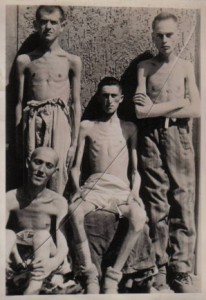 Consider the extent of the irresponsible misinformation on the USHMM website when you learn that these are German men after being interned at the notorious Bad Nenndorf secret prison set up in Germany by the British during their occupation of north-west Germany in 1945. I used this photo in the post for my Oct. 29 radio program The Heretics Hour. The treatment of the prisoners in this camp by the British was far worse than anything experienced by those at Buchenwald. Below are more pictures of documented Bad Nenndorf victims. All suffered from actual, unnecessary starvation.
Consider the extent of the irresponsible misinformation on the USHMM website when you learn that these are German men after being interned at the notorious Bad Nenndorf secret prison set up in Germany by the British during their occupation of north-west Germany in 1945. I used this photo in the post for my Oct. 29 radio program The Heretics Hour. The treatment of the prisoners in this camp by the British was far worse than anything experienced by those at Buchenwald. Below are more pictures of documented Bad Nenndorf victims. All suffered from actual, unnecessary starvation.
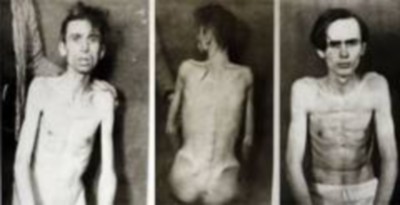
More needs to be done to expose all the photographic “evidence” in the USHMM archives that are forgeries or are mislabeled. There is obviously no vetting or double-checking of what is turned in by Jewish contributors; it’s accepted and catalogued “as is,” just like at Yad Vashem in Israel. We must realize that there is very little about the “Holocaust” that is not fraudulent, either by design or through negligence. The USHMM is a totally Zionist operation and thus is a propaganda mill, not an institution pursuing historic accuracy.
Tutorial on Cast Shadows
In case some readers have trouble understanding shadows and why the shadow “drawn” around the head and body of the seated man (or he was originally seated in front of a wall) are a give-away for forgery, I am presenting two images here that should explain it.
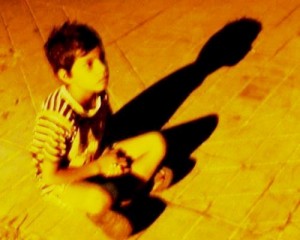 Notice that the shadow cast by this boy (right) sitting in open space is not around his body but on the ground. Shadows cannot be seen “in the air” but only on a surface.
Notice that the shadow cast by this boy (right) sitting in open space is not around his body but on the ground. Shadows cannot be seen “in the air” but only on a surface.
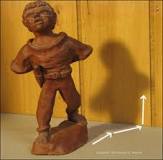
Likewise the statue at left is a short distance away from a wall. But notice that the shadow follows the floor before it reaches the wall, making the shadow on the wall quite a bit shorter than the object itself.
12 Comments
Category Featured | Tags: Tags: Bad Nenndorf, Buchenwald Lie-beration, bunks, composite photograph, forgery, USHMM,
Social Networks: Facebook, Twitter, Google Bookmarks, del.icio.us, StumbleUpon, Digg, Reddit, Posterous.
Sunday, December 23rd, 2012
By Carolyn Yeager
copyright 2012 carolyn yeager
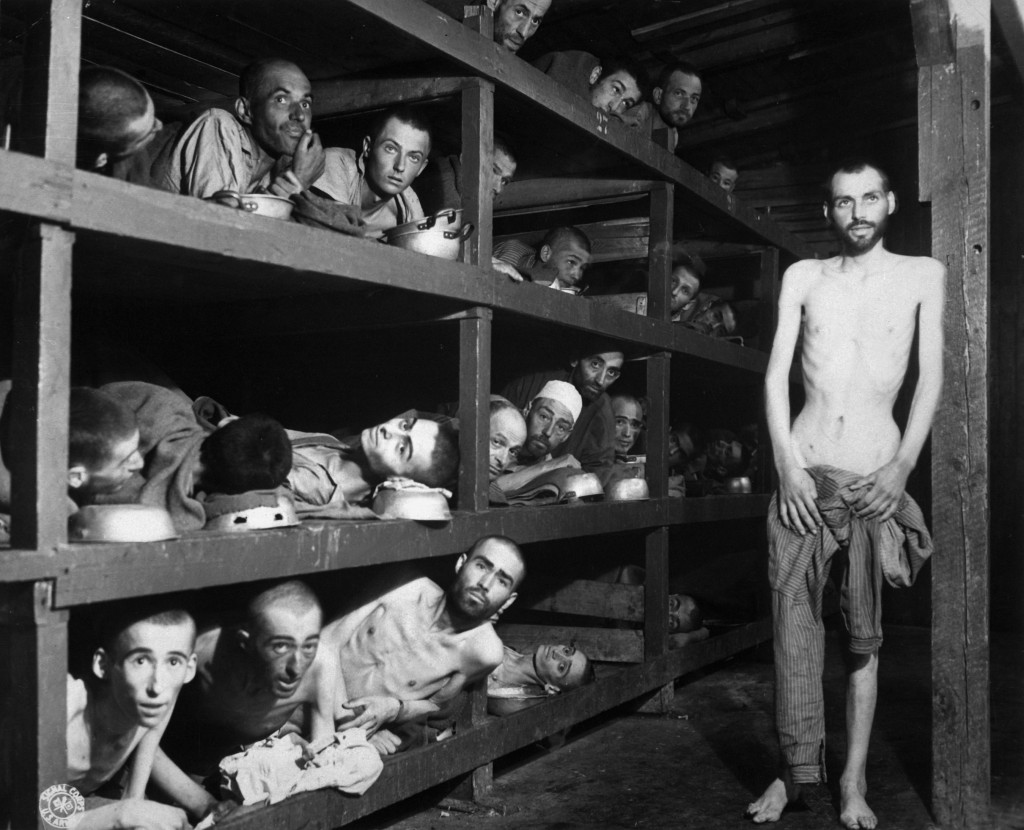
Do you remember the nursery rhyme that goes:
Sugar and Spice and all things nice, that’s what little girls are made of.
How about this one:
Magic and Trickery and all things fakery, that’s what “the holocaust” is made of.
This very famous image associated with the so-called “Holocaust” that was discussed in the previous post has turned out to be fraught with fakery. A sharp-eyed reader, Paul Borresen, noticed something that, once seen, makes one wonder how it was not seen before!
What he noticed is that, in addition to the forged standing man exposed in my previous post, one of the men in the bunks appears twice in this Famous Buchenwald Lie-beration Photo, and the similarity is unmistakeable.
Viewing the photo above, enlarged as much as it can be … find the young man lying on his back with head turned toward the photographer, in the 2nd row up from the bottom, 3rd from the left. His head is resting on his food bowl. (close-up on left, below, designated ‘Original’)
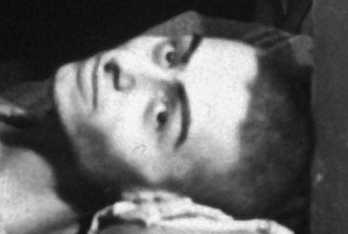
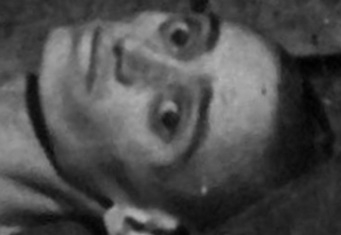
Now look at the young man in the same position in the bottom row, 4th from the left. He is the same man! (close-up on right, above, designated ‘Copy’) The food bowl has been removed from underneath his head, leaving it to a military intelligence photo-retoucher to redo his throat and neck, but in a very un-anatomical manner. Have you ever seen a neck that looked like that? I have not. In an attempt to retain a lesser portion of the ‘gown’ he was wearing so that it would not look the same as the ‘original,’ more bare skin is left showing, but without any anatomical correctness whatsoever.
The retoucher was not a trained artist and was in over his/her head with this assignment. For example, look at the ear. It consists of a few strokes of light-colored paint in an attempt to make something resembling an ear, but failing. Ears are one of the most difficult parts of the body to draw or paint in a convincing manner, but it was necessary to add an ear to this ‘copy’ because the ear is not showing on the original man in the bunk above; it is buried against the upside-down food bowl and some material that’s covering it. The botched ear of the ‘copy’ is one of the biggest giveaways of fakery in this photo, but not the only one.
What’s with all these thick, black eyebrows?
Let’s look at the eyes and eyebrows next. The man whom we are calling “the original,” has very dark, thick eyebrows but otherwise looks normal. The shadow under his chin is probably what was actually there – bringing attention to the fact that a very bright light source in a dark room was shining on the men, and hitting the lower two rows of bunks more than the upper two rows. His “copy” also has very dark, flat eyebrows but they have been redrawn to begin higher up from the bridge of the nose and extend down to the outside corner of the eye, giving him a wild look. Adding to this wild-eyed look is the delineation of more distinct eyelids, rounding the eyes and enlarging the irises, all of which create the zombie look which the ‘original’ doesn’t have.
A couple more things were done in a futile effort to camouflage this ‘copy’: the rounding of the forehead, head, and hairline, and the squaring of the chin and lower jaw. A crude line of black paint, applied all the way up to the big, white ‘cauliflower’ ear, was evidently thought to suffice for a shadow under chin and jaw. Look closely especially where it meets the ear and you can recognize it is paint.
Yet, the nose, mouth, upper jaw and facial shadows remain exactly the same in both figures. The result is a grotesque second person that I suppose has been eliciting sympathy from clueless viewers all these years.
This grotesque, over-worked ‘copy’ is also smaller than it should be for the bunk it occupies – actually being the same size as the man peering out from the next bunk further down. Maybe the forgers thought this would make him look like a young boy. If so, they failed to realize that boys don’t have tiny heads! Now, this peering man has clearly had his eyebrows and eyes emphasized with black paint or pencil. Or he may be totally fake. Others whose eyebrows were treated similarly are: The “elie wiesel” face has heavily emphasized eyebrows; also the second and third man in the third row, and all the men in the top row. I believe the best explanation for this phenomenon is this: the poorly painted eyebrows of the ‘copy’ would stand out too much from the natural-looking eyebrows of all the rest, so it was decided to give a swipe of black paint to many other eyebrows also, including our ‘original.’
As a practicing artist most of my life, from childhood on, who has drawn and painted hundreds of faces and done many portraits, I know quite well how to touch up faces and how tiny adjustments can make a big difference in attaining a likeness. The assignment here was to do the opposite of attaining a likeness; it was to take a photographic carbon copy and make it look unlike the original. If I had done the work on this photograph it would be far superior to the image we have, which is a really sloppy job by people who are not artists and therefore don’t have “an eye” for how things actually look and/or don’t know how to make it look that way. Which is a good thing for us!
NEW ENLARGED IMAGES! In these close-ups showing more of the neck and the space around the faces. we can see more clearly how the head of the “copy” in the lower bunk is angled back, just slightly, since he is lying with his head directly on the floor of the bunk, not propped up as is the “original.” I think it’s likely that after altering the face and hair, and adding an “ear,” the forgers severed the face/head at the jawline and proceeded to paint a brand new neck that would fit the newly angled face with the slightly raised chin. This is why everything below the chin is so horribly wrong. We can see a collar bone and shoulder in the ‘original,’ but there is no bone structure at all in the ‘copy.’ The crude black line representing a shadow under the chin serves to “attach” the two parts together.
The ‘copy’ also has far less contrast, is overall grayish, which would happen from all the retouching, or also that this copy was set for low contrast. We can see that the shadows on the side of the face follow the same pattern even though they’ve been interrupted here and there. We can also see clearly how the upper line of the face was indented right below the cheekbone, and was added to along the mouth area. The line of the mouth between the upper and lower lips goes all the way to the edge of the face, but on the ‘copy’ it stops short of the edge. You can see the gray paint added at that upper corner of the mouth.
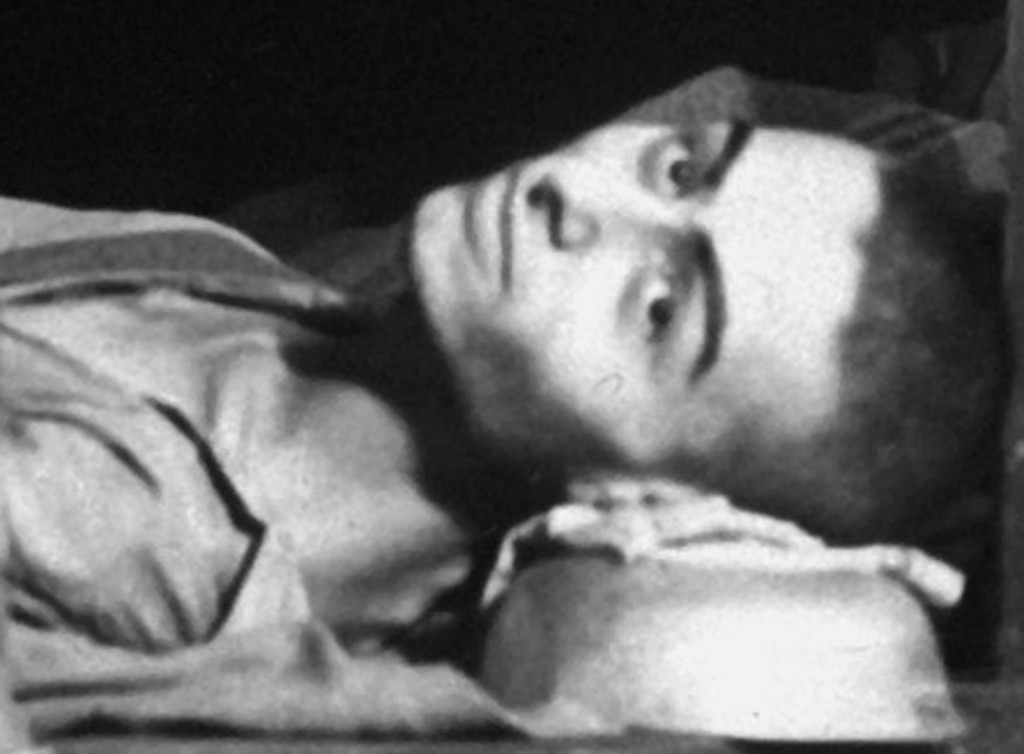
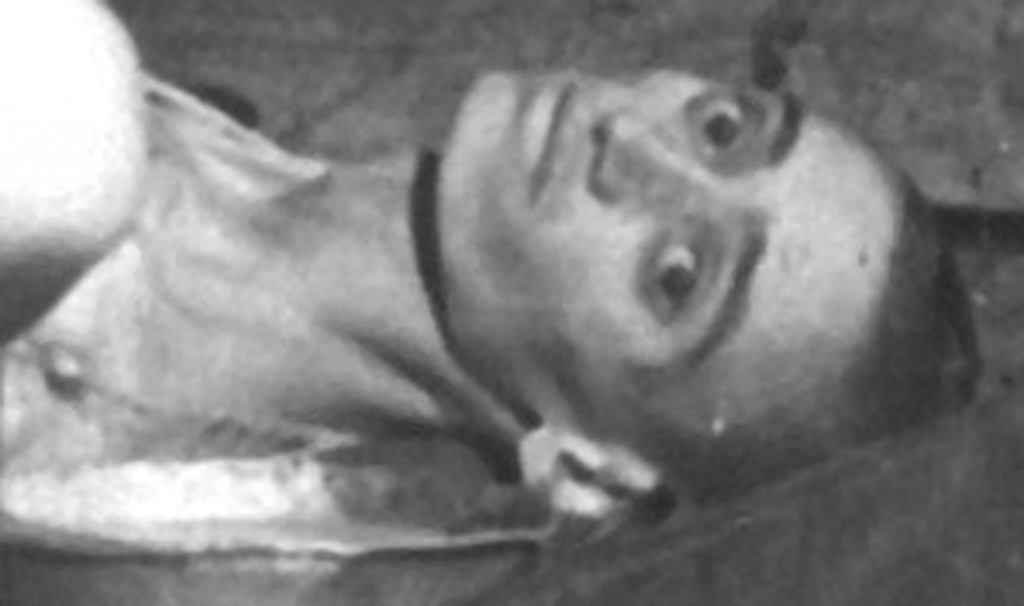
Hundreds of forged and mislabeled photographs make up the “Holocaust”
This is one photograph out of many that were also forged. I believe it is one of the most important because it has been given such a prominent place among the documents “proving” the “Holocaust.” Elie Wiesel, or his handlers, no doubt selected this photo – from many possible others wherein he could be falsely identified as one of the crowd – because it was already so well-known and was in many books and publications. Therefore, whenever it is published somewhere, it can be said that Nobel Prize winner Elie Wiesel is in the picture. However, they didn’t count on it being exposed as a fraud – they never do. But now it has been, and it’s up to us – all of you reading this – to see that the exposé becomes known everywhere this photograph appears. This is what it will take to break the spell.
What we have to fight against – our own people
A fellow revisionist who helps me with technical issues from time to time for this blog actually wanted me to hold back on this because he could not be sure that the two figures discussed in this article are the same man! What would it take to convince him? A confession from the perpetrators? A corroboration from an authority figure or a Jew? Why the difficulty in contradicting the given narrative?
A poster at Stormfront who boldly calls himself “The Hammer of God” had this to say when confronted with the empty black area in the NYTimes reprint:
Idk, newspapers did have pretty low-quality pictures at that time, so maybe that whole area was just set to black, but it looks bright enough for that person to have shown up. The lighting actually seems a bit brighter on that man, which makes it even stranger why that section would appear black. So, perhaps it is a forgery, but I can’t say for certain.
People like ‘The Hammer” should spend more time studying how the magic spell works. It works like this: Evidence doesn’t count; don’t trust it; don’t trust your own brain; trust the consensus. Far too many of us cannot break out of the consensus about the “Holocaust” and the ” evil Nazis.” For this reason, we need to clearly understand what is being done, and how it’s being done. The “how” is very important. It’s a kind of sleight of hand, a magic act, and we are the ones being both entertained and kept in servitude by it. Understanding this is how we will break the spell.
7 Comments
Category Featured | Tags: Tags: Elie Wiesel, fakery, famous Buchenwald photo, Holocaust, magic, photo retouching, trickery,
Social Networks: Facebook, Twitter, Google Bookmarks, del.icio.us, StumbleUpon, Digg, Reddit, Posterous.
Wednesday, December 19th, 2012
By Carolyn Yeager
copyright 2012 carolyn yeager

This is the photograph that Allied Supreme Commander General Dwight David Eisenhower ordered, in April 1945, to be posted in every German town and city 1 to show the defeated population the “true meaning of Nazism.”
Was this photo made to order according to Ike’s specifications?
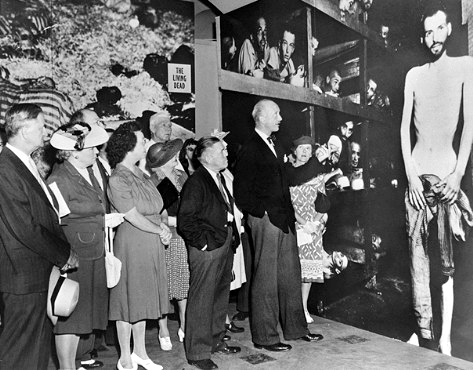 A huge blown-up version then went on tour in the United States for the same purpose, to impress on the American people what evil they had gone to war against; why the sacrifice of blood and treasure was justified! Left: “A traveling exhibit of larger than life size photographs was first shown in St. Louis, MO in summer 1945 and then taken to Washington, DC.
A huge blown-up version then went on tour in the United States for the same purpose, to impress on the American people what evil they had gone to war against; why the sacrifice of blood and treasure was justified! Left: “A traveling exhibit of larger than life size photographs was first shown in St. Louis, MO in summer 1945 and then taken to Washington, DC.
It was plastered on the front pages of newspapers across the country. Thus it became one of the most iconic images representing WWII and of what later came to be known as “The Holocaust.” The intention was to portray the war as a noble effort to “save the Jews from enslavement and extermination,” just as the equally bloody American Civil War had come to be taught as a war “to free the slaves,” i.e. the Negroes who were not citizens of the country they were living in.
Both are black propaganda campaigns that still use whatever is at hand, whether it be subterfuge or not.
In the case of the above photograph, we have learned that the standing figure, the part that makes the biggest, most memorable impact on the viewer, was added later – it was not in the original photo allegedly taken by Private H. Miller of the Civil Affairs Branch of the U.S. Army Signal Corps on April 16, 1945, five days after the “liberation” of the Buchenwald Concentration Camp by American forces.
A blogger, the owner of the Winston Smith Ministry of Truth website who goes by the nickname Black Rabbit, decided a week or so ago, out of curiosity, to order the New York Times newspaper article from May 6, 1945 in which this photo was published, and when it came the photo looked like this:
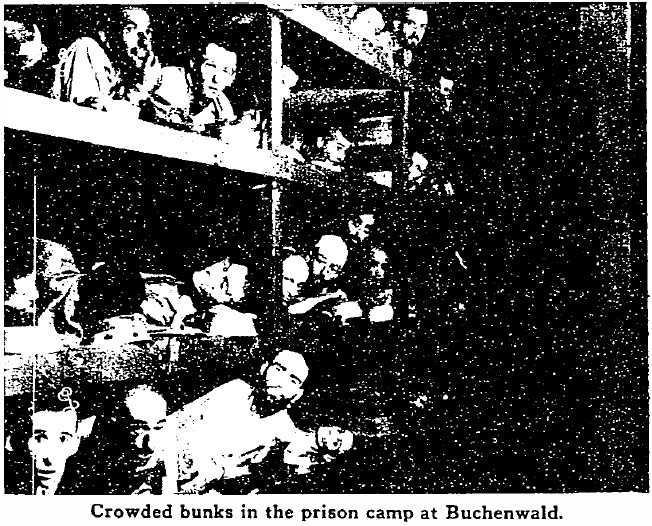
Here is page 2 and 3 of the New York Times article (click to show entire page):
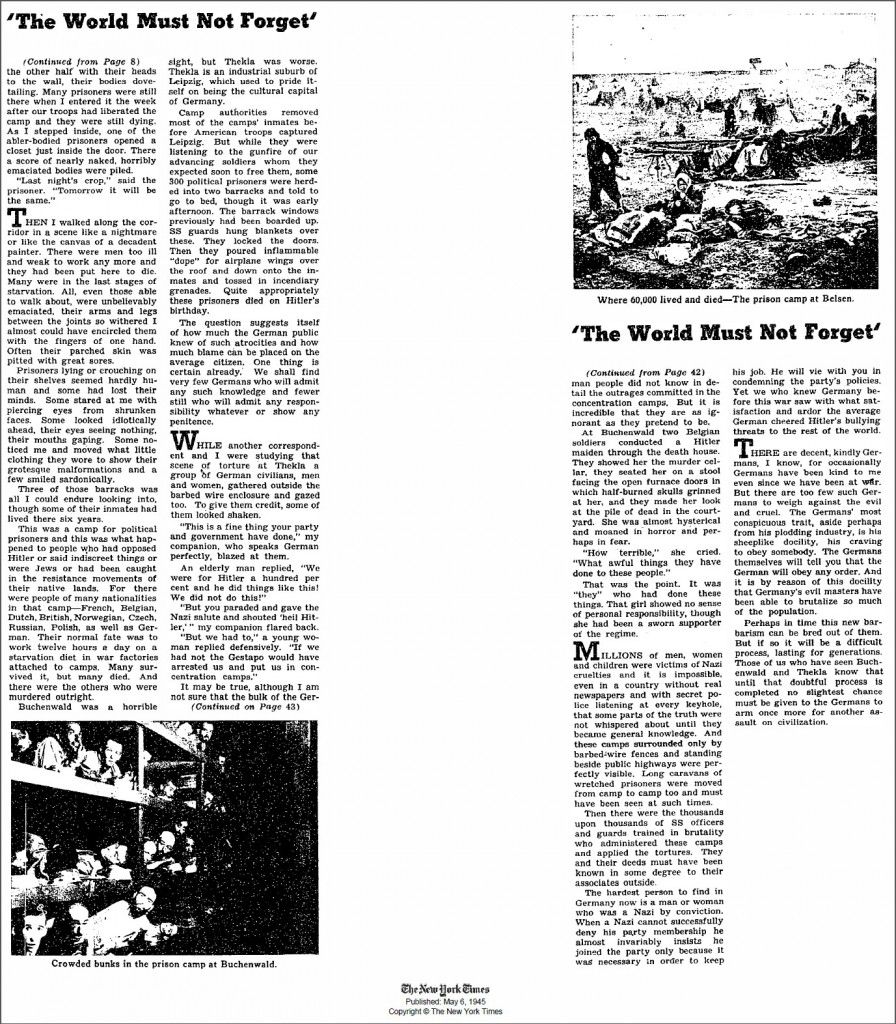
What a shock to see only an empty dark space, and in the New York Times no less!
What happened to the standing man? I was the first to bring it to the attention of the participants in the comment section of furtherglory’s Scrapbookpages Blog after Black Rabbit posted a link to the original article there, and then we quickly began noticing the tell-tale signs of FORGERY about this strange figure who had always appeared odd to me standing there naked as he is, but did not arouse enough suspicion amidst all of the onslaught of “holocaust” imagery, stories and news articles with which we are constantly being bombarded. We see what we are supposed to see, what we’re told we’re seeing, and almost always leave it at that. It is also one of the better photo-forgery jobs of Allied holocaust black propaganda – could that be because it was being done at the behest of the Supreme Commander himself?
But let me point out some problems with this figure:
- His position in relation to the post is an impossible one (see top photo; click once on image and then again for full enlargement). He is not leaning against the post, but neither is he standing in front of the post. His feet are in line with the base of the post, but his left shoulder and arm are in front of the post – without any shadow of any kind. There is something ghostly about this figure, as though he’s an apparition.
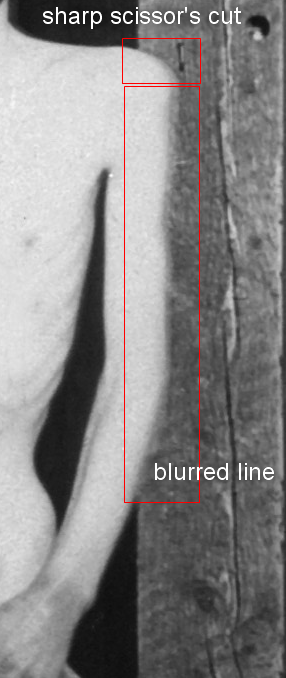 The edge of his left arm is fuzzy, as if it is drawn or painted where it meets the post (detail right). The rest of the outline of his shoulders and arms is very sharp, as though cut with scissors. [In most large-scale reproductions of this photo we have seen (as shown on the Winston Smith Blog), the left edge of the arm is cropped because the larger the image the more noticeable it is.
The edge of his left arm is fuzzy, as if it is drawn or painted where it meets the post (detail right). The rest of the outline of his shoulders and arms is very sharp, as though cut with scissors. [In most large-scale reproductions of this photo we have seen (as shown on the Winston Smith Blog), the left edge of the arm is cropped because the larger the image the more noticeable it is.- Notice the blinding whiteness of his torso, and how different it is from his face, hands and legs which are darker (top photo again). The more one studies the torso and arms, the more they look like a drawing rather than a photograph. Notice how faint are the nipples and definition on his chest compared to the man in the lower bunk who is pushing himself forward the better to be seen.
- Notice the relaxed, almost dreamy expression on the face of the standing man (detail below): his lips are parted in a smile; his eyes are looking off into the distance, not at the photographer. He appears in an untroubled state of mind, unsuited to the environment he’s in and unlike the other men .

- 5. A light source seems to be coming from above right as we face the photo, but the shadows on the legs and feet suggest a light source directly from above. Also, the angle of the shadows on the floor made by the post and by the right leg of the standing figure are not aligned.
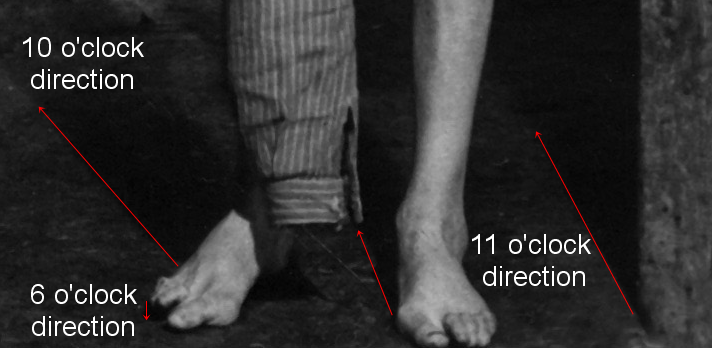
6. Ask yourself why he would be standing there completely nude, with that unlikely expression on his face, five days after the liberation? Also ask yourself why these men would still be lying in these bunks fully dressed, though some having taken their shirts off for effect, five days after the liberation? The only answer is that it’s a staged, arranged photo-shoot for propaganda purposes, not an impromptu entry by a photographer right at the time of liberation – as we are led to believe (because we are supposed to believe it) by the captions that accompany the photo. For example, in the Moberly (Missouri) Monitor-Index on April 30, 1945, the caption to this photo reads: “Slave laborers in their crowded rough bunks in the Buchenwald concentration camp near Jena, Germany, as they were found when U.S. troops of the 80th Division entered the camp.”
Fakery such as this is common in war propaganda; it just usually doesn’t last so long
We not only have the NYT newspaper article showing the photograph without the standing man, but we can also point out tell-tale signs that this figure was added to the photo … and that it was itself doctored to show a very skinny torso of a “starving” man. What deceit! If Eisenhower propaganda specialists had really found such scenes, they would not have had to invent them!
And yes, I’m asking how many personnel were aware, had to be aware, of this type of forgery. And some still living who are still perfectly aware that “The Holocaust” was and is a post-war intelligence operation with no holds barred. For example, so many of the photos that are archived and sold to the gullible public by the propaganda mill that goes by the name of the United States Holocaust Memorial Museum (USHMM) (using your tax dollars) are wildly mislabeled. The USHMM identifies this very photograph as follows:
Former prisoners of the “little camp” in Buchenwald stare out from the wooden bunks in which they slept three to a “bed.” [Photograph #74607]
Elie Wiesel is pictured in the second row of bunks, seventh from the left, next to the vertical beam.
The man in the bottom left hand corner has been identified as Michael Nikolas Gruner, originally from Hungary, Gershon Blonder Kleinman or Yosef Reich. Isaac Reich is in the bottom row, second from the right and Max Hamburger is on the bottom row, fourth from the left. Perry Shulman from Klimitov, Poland is on the top bunk, second from the left (looking up). The man in the second row, third from left has been identified as Dawid Najman. The man in the second row, fourth from the left has been identified as Abraham Hipler; Berek Rosencajg from Lodz or Zoltan Gergely from Cluj. The man on the third bunk from the bottom, third from the left, has been identified as Ignacz (Isaac) Berkovicz, Abraham Baruch and Paul Argiewicz . Juraj (now Naftali) Furst is pictured in the third bunk, fifth from the left. Standing on the right is Chaim David Halberstam.
Others say the standing man is Simon Toncman, who after the ‘Liberation’ returned to his home country The Netherlands, started a family and became a successful businessman. He refused to talk about this photo until the day he died. 2 (Why would that be? Because he knew it was a fake! And because he had been told to keep quiet about it. That’s the best, and only reasonable explanation.)
Of the identified men, one is definitely mis-identified! — and that is Paul Argiewicz. The real Paul Argiewicz was discovered by furtherglory; I picked up his work here (scrowl down to the German drivers license). How could the “Jewish Organizations” with access to Bad Arolson get that so wrong? They all do it all the time. For example, the ‘meantime -Allen Hall” article says that “Red Cross records show Heiman Leefsma survived Barrack 56 as a 20-year-old.” Yet when we see who he is identified as in the Flicker picture, he has a balding head and looks like the oldest man there.
And then there is Elie Wiesel! Please see especially here for proof that the man in the bunk is NOT Elie Wiesel. So that is more fakery surrounding this photo, but in this case the person was really in the original photograph, but is an unknown person. The decision to call that man Elie Wiesel was only made around 1983, with a Nobel Prize in mind.
Both the USHMM and the Allan Hall article are full of errors. There is no need for holocaust “historians,” filmmakers, or “researchers” to be concerned about accuracy — it doesn’t matter how iconic or world-famous they are. Sloppiness goes unpunished, especially since so much of it is on purpose — to deceive and keep the myth going. I will be posting about some other fraudulent pictures from Buchenwald in the future.
End Notes:
1. “US army commander General Dwight Eisenhower ordered this picture to be posted in every German town and city to show the defeated population the true meaning of Nazism,” writes Allan Hall. http://www.meantime.com.au/mean-time-articles/2008/8/12/60-years-on-the-faces-of-nazi-shame-get-their-names-back/
2. Same source (meantime.com): Quote – “Now, 63 years after they were liberated, they have been united again in print by a German newspaper granted rare access to the files of the Red Cross Tracing Service at Bad Arolsen, Germany.
Using the original German SS registration cards and the camp’s “Todesbuch” – book of death – researchers were able to match up names with Jewish organisations around the globe.
Paul Argiewicz, 82, is now living in the US. He lost his parents in the gas chambers and is a regular on American TV shows talking about his experiences.
Red Cross records show Heiman Leefsma survived Barrack 56 as a 20-year-old. A Dutch national, he vanished shortly after liberation and inmate 130305 has not been heard from since.
Nikolas Gruener, now 80, is a Hungarian Jew who was suffering from TB at the time of liberation. “We warmed ourselves on the bodies of the dead before they cooled down,” he said. A successful businessman after the war, he took part in a number of interviews recently for director Steven Spielberg’s Holocaust archive. He lost his parents and two brothers in the camps.
Max Hamburger is now 88. He was active in the resistance in Amsterdam. He survived the death factory of Auschwitz because he was employed as a medic and went on to Buchenwald, where he weighed just 19 kilograms at liberation. After the war he settled in Belgium,where he became a psychiatrist. He speaks regularly to universities about the Holocaust and his experiences.
Nobel Prize winner Elie Wiesel is one of the most well-known Holocaust survivors. Wiesel, who coined the phrase “never again”, is now 79. He was awarded the peace prize in 1986. “That is me,” he said, when shown the photo in the 1960s.
Simon Toncman, a Dutch Jew, was 28 at the time of liberation. He married a survivor from Auschwitz and went on to have a successful career in accountancy in his homeland before dying from a genetic bowel complaint in 1975. He never spoke about his Holocaust experiences but revelled in his “wonderful family life”. He had nine grandchildren before his death.
Mel Mermelstein, 81, is a Hungarian Jew whose whole family perished in Auschwitz. He was portrayed by Leonard Nimoy in a 1991 movie called Never Forget, about his lawsuit against Holocaust deniers in America who suggested the gas chambers were a myth. His autobiography is called By Bread Alone and he too speaks regularly about his time in the camps. Of the photo, he said: “We were alumni of some of the most terrible places on earth. This picture and the men in it mean more to me than I can say.”
26 Comments
Category Featured | Tags: Tags: Elie Wiesel, famous Buchenwald photo, forgery, General Dwight Eisenhower, New York Times, Paul Argiewicz, photo-fakery, Scrapbookpages Blog, Simon Toncman, USHMM, war propaganda, Winston Smith Ministry of Truth,
Social Networks: Facebook, Twitter, Google Bookmarks, del.icio.us, StumbleUpon, Digg, Reddit, Posterous.
Tuesday, December 18th, 2012
[email protected]
This is the new address for this website, or use the contact form on the menu bar under “About.”
Sunday, December 16th, 2012
To anyone who has sent an email to [email protected] in the past month or so:
I am sorry that it was not received because that email account has not been available to me for some time. I believe it was cancelled during the many changes CODOH has been undergoing recently and whatever it contained has been lost. If you want to get some information to me, just write it in a comment on the blog; I can reply to you from that without posting the comment.
Elie Wiesel Cons The World is moving and will no longer be under the sponsorship of CODOH, but it will continue as before under my direction and you will not notice any difference. I will let you know when the move is complete and there is an email account again. I could really use some contributions to help with the move and to pay the hosting costs in the future.
Many thanks to Bradley Smith for his generous support for this site since it’s beginning in 2010. He is definitely one of the good guys. Let’s all move on into a year of great accomplishment in 2013. Some exciting new breakthroughs are coming! (As soon as I get the time to write about them here.)
Tuesday, December 4th, 2012
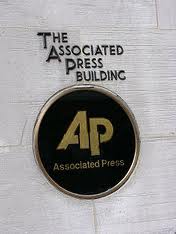 by Carolyn Yeager
by Carolyn Yeager
My latest phone call on the morning of Monday Dec. 3 to the Associated Press office in New York brought the following results: The answerer, upon hearing my name, immediately connected me to Corporate Communications, where I spoke to the same woman I spoke with the previous Monday, Nov. 26. I identified myself and told her I had re-sent the first email from Nov. 8 (rather than the second one from Nov. 14) as she requested but did not receive any acknowledgment of receipt from anyone. She said she forwarded it to the proper parties, but had not guaranteed there would be a reply.
In answer to my persistent questions, to which she finally gave her name as “Lauren,” though she would not give me a last name, she added the information that the email was forwarded to “the journalist and the news editor.” Lauren would not reveal the name of the news editor. She also would not answer whether AP was getting other emails and phone calls about this subject. She said to this, and so many other questions, “I can’t tell you that.” Thus the road forward on this issue is being “stonewalled” by the guilty. As we know, they are able to write and publish tons of prose about the impossible stories of the “survivors” of the “Holocaust,” but go deaf, dumb and blind when it comes to answering simple questions of fact concerning these stories. Let’s take a look at what they are actually guilty of.
 Stonewalling: To refuse to answer or cooperate (esp. in supplying information).
Stonewalling: To refuse to answer or cooperate (esp. in supplying information).
I have asked for further elucidation from reporter Verena Dobnik about her vaguely-worded but pointed reference to seeing a “death camp” tattoo on the left arm of Elie Wiesel during an interview session … that has never been seen by anyone! Yet, not a single further word has come forth from her.
What is the Associated Press
[From Wikipedia] The Associated Press is an American news agency, a cooperative owned by its contributing newspapers, radio and television stations in the United States, which both contribute stories to the AP and use material written by its staff journalists. Many newspapers and broadcasters outside the United States are AP subscribers, paying a fee to use AP material without being contributing members of the cooperative. The AP staff is represented by the Newspaper Guild union, which operates under the Communication Workers union, which operates under the AFL-CIO. The content of AP news stories relating to current political issues that impact union interests has increasingly been subject to claims of news media bias. Pictured at right: AP headquarters at 450 West 33rd Street, New York City and above right: Logo on the former AP Building in New York City
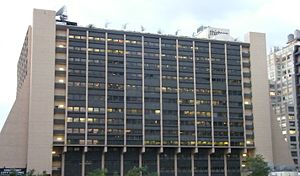 Journalism Scandals
Journalism Scandals
Journalistic scandals include: plagiarism, fabrication, and omission of information; activities that violate the law, or violate ethical rules; the altering or staging of an event being documented; or making substantial reporting or researching errors with the results leading to libelous or defamatory statements.
All journalistic scandals have the common factor that they call into question the integrity and truthfulness of journalism. These scandals shift public focus and scrutiny onto the media itself. Because credibility is journalism’s main currency, many news agencies and mass media outlets have strict codes of conduct and enforce them, and use several layers of editorial oversight to catch problems before stories are distributed.
However, in some cases, investigations later found that long-established journalistic checks and balances in the newsrooms failed. In some cases, senior editors fail to catch bias, libel, or fabrication inserted into a story by a reporter. In other cases, the checks and balances were omitted in the rush to get an important, ‘breaking’ news story to press (or on air). [Not the case here]
How is fabrication defined
A fabrication is a lie told when someone submits a statement as truth, without knowing for certain whether or not it actually is true [or knowing for certain it is not true]. Although the statement may be possible or plausible, it is not based on fact. Rather, it is something made up, or it is a misrepresentation of the truth. Examples of fabrication: A person giving directions to a tourist when the person doesn’t actually know the directions. Often propaganda is fabrication.
Propaganda
A form of communication that is aimed at influencing the attitude of a community toward some cause or position by presenting only one side of an argument. Propaganda is usually repeated and dispersed over a wide variety of media in order to create the chosen result in audience attitudes.
Lie
To lie is to deliver a false statement to another person(s) [by speaking or writing] which the speaking/writing person knows is not the whole truth, intentionally.
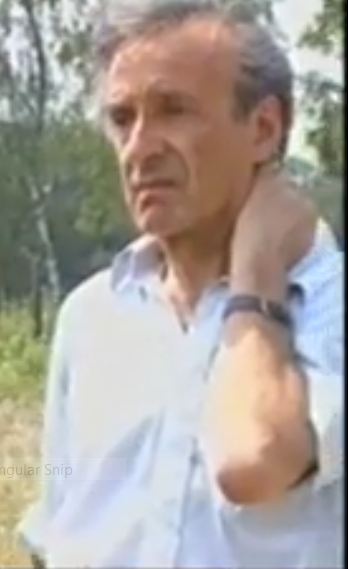 Does Verena Dobnik’s reporting of seeing a non-existent tattoo on a famous fabricator’s arm amount to a journalism scandal?
Does Verena Dobnik’s reporting of seeing a non-existent tattoo on a famous fabricator’s arm amount to a journalism scandal?
Yes, by all criteria it does. But if no one cares, it will continue to pass unnoticed. One thing people need to keep in mind: If Verena Dobnik really had the experience of seeing Wiesel’s tattoo, as she claims, she would certainly be prepared to come forth and verify it, in the form of some kind of statement. That she doesn’t, and that her news editor and the AP are also “stonewalling” this question, tells us in no uncertain terms that she is guilty.
This website, Elie Wiesel Cons The World, charges Verena Dobnik with committing journalistic fraud, of intentionally lying in her reported interview with Mr. Wiesel about seeing his tattoo … and 2) in like manner her news editor is guilty of allowing her false claim to go past the checks that should have been performed, and 3) the AP is guilty of covering up the crime, rather than investigating it, once it was brought to their attention. 4) Lauren in Corporate Communications is guilty of “following orders” to enable the cover-up to continue. I understand she is “just doing her job” — like all those concentration camp guards that Wiesel and Dobnik like to condemn.
This calls for a lawyer, but …
This would be an excellent case if there were a lawyer that would undertake it. There are a few attorneys who will act as defense counsel in holocaust-related cases, but none who will go on the offense. The simple demand would be, “Show us the tattoo! It’s very easy to defend yourself, so why don’t you?” The silence in the face of that request tells us, by simple deduction, there is no tattoo. Thus we should keep the letters, emails ([email protected]) and phone calls (1-212-621-1500) going, and post these blogs around the Internet and to email contacts. Don’t let the AP off the hook.
Call or twitter these two people directly:
Paul Colford
Director of Media Relations
Twitter: http://twitter.com/PDColford_AP
+1 212.621.1895
Erin Madigan White
Manager of Media Relations
+1 212.621.7005
http://twitter.com/emadiganwhite
10 Comments
Category Featured | Tags: Tags: AFL-CIO, AP Corporate Communications, Associated Press, Elie Wiesel's non-existent tattoo, Erin Madigan White, journalism scandals, journalistic fraud, Paul Colford, stonewalling, Verena Dobnik,
Social Networks: Facebook, Twitter, Google Bookmarks, del.icio.us, StumbleUpon, Digg, Reddit, Posterous.
 Here we see a very bizarre scene of clothed men being photographed lying in bunks, while a naked man sits on a bench in front of them. They are not looking at him and he seems unaware of them. And why not? This is clearly a composite photograph made up of two unrelated scenes.
Here we see a very bizarre scene of clothed men being photographed lying in bunks, while a naked man sits on a bench in front of them. They are not looking at him and he seems unaware of them. And why not? This is clearly a composite photograph made up of two unrelated scenes. So far so good. But once again, the shadows present a problem. Notice that there is a dark shadow behind every man in the bunk cast on the wall behind him, due to the bright flash of the camera and maybe even a spotlight shining on them. The naked man also has a similar black shadow around his head and along his right side although there is only empty space behind him. There is no wall, so what is the shadow being made on? Notice there is no shadow created by his legs. This shadow seems to me to be totally impossible. We don’t see a shadow made “in the air” behind the standing naked man in the Famous Buchenwald Lie-beration photo discussed in the previous posts. But here we do.
So far so good. But once again, the shadows present a problem. Notice that there is a dark shadow behind every man in the bunk cast on the wall behind him, due to the bright flash of the camera and maybe even a spotlight shining on them. The naked man also has a similar black shadow around his head and along his right side although there is only empty space behind him. There is no wall, so what is the shadow being made on? Notice there is no shadow created by his legs. This shadow seems to me to be totally impossible. We don’t see a shadow made “in the air” behind the standing naked man in the Famous Buchenwald Lie-beration photo discussed in the previous posts. But here we do. Consider the extent of the irresponsible misinformation on the USHMM website when you learn that these are German men after being interned at the notorious Bad Nenndorf secret prison set up in Germany by the British during their occupation of north-west Germany in 1945. I used this photo in the post for my Oct. 29 radio program The Heretics Hour. The treatment of the prisoners in this camp by the British was far worse than anything experienced by those at Buchenwald. Below are more pictures of documented Bad Nenndorf victims. All suffered from actual, unnecessary starvation.
Consider the extent of the irresponsible misinformation on the USHMM website when you learn that these are German men after being interned at the notorious Bad Nenndorf secret prison set up in Germany by the British during their occupation of north-west Germany in 1945. I used this photo in the post for my Oct. 29 radio program The Heretics Hour. The treatment of the prisoners in this camp by the British was far worse than anything experienced by those at Buchenwald. Below are more pictures of documented Bad Nenndorf victims. All suffered from actual, unnecessary starvation. Notice that the shadow cast by this boy (right) sitting in open space is not around his body but on the ground. Shadows cannot be seen “in the air” but only on a surface.
Notice that the shadow cast by this boy (right) sitting in open space is not around his body but on the ground. Shadows cannot be seen “in the air” but only on a surface.

















